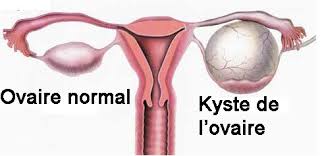Benign ovarian cysts
Functional cysts are due to a “hormonal imbalance” that causes the transformation of a physiological follicle or corpus luteum into a cyst
Normal ovary & Ovarian Cyst

What is an ovarian cyst?
The ovarian cyst is by definition an ovarian tumour most often containing fluid.
How is an ovarian cyst diagnosed?
An ovarian cyst can be diagnosed in the presence of abdominal pain, infertility or disorders of menstrual cycles. It can also be discovered incidentally during a routine examination or an ultrasound performed for another reason. It is the clinical examination and the ultrasound that enable the diagnosis to be made.
What are the different types of ovarian cysts?
There are generally:
Functional cysts: they grow during the menstrual cycle due to a hormonal imbalance. These ovarian cysts must not be operated. They resolve spontaneously or after drug treatment.
Organic cysts: they can complicate or degenerate. Organic ovarian cysts should be removed and analysed. There are benign cysts and cysts at the limit of the malignancy called “borderline”.
To clarify the nature of the cyst, an MRI and a blood test can be made to estimate tumour markers.
What are the complications of ovarian cysts?
In the absence of treatment, ovarian cysts may complicate:
What does ovarian cyst treatment consist of?
It is laparoscopy that allows the diagnosis and performance of a cystectomy, that is to say the removal of the cyst from the ovary. In a menopausal patient, removal of the two ovaries with the tubes is the rule.
If the ovarian cyst is large enough, of organic nature and diagnosed in early pregnancy, an intervention can be scheduled from the 4th month.








